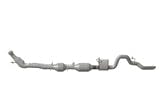Buyers of the latest Dodge 3/4- and 1-ton pickups with the Cummins Turbo Diesel option might want to order them in shades of green, because their engines are emissions-legal not just for 2007, but for 2010 and beyond, according to Cummins. This makes the popular engine the first to meet the federal Environmental Protection Agency's upcoming limits for nitrogen oxides and particulates that will be a challenge for most other diesels in January of 2010.
The future is both under the hood, in the advanced combustion system of the 6.7-liter inline Six (otherwise known as the ISB), and hanging on the frame, in the exhaust system. There, as part of the aftreatment system, is an "NOx adsorber catalyst," which scrubs nitrogen oxides from the exhaust and changes them to other, less objectional chemicals, including water vapor. Bill Stahl, Cummins' director of OEM service, described the system at an industry maintenance meeting earlier this year.
The NOx adsorber (that's adsorber with a 'd,' because the device accumulates the target substance on its internal surfaces rather than soaking it up, which is what happens during absorption, with a 'b') is the second of three aftertreatment devices. It's mounted between a diesel oxidation catalyst (which has been used on many exhaust systems since '02 and earlier) and a diesel particulate filter (which is new to '07-legal engines, and whose function we've described often in previous articles).
Stahl explained that exhaust gas moves from the engine and turbocharger and enters the three aftertreatmentdevices in this order:
- Oxidation catalyst, where NOx is converted to nitrogen dioxide (NO2) and heat is generated.
- NOx adsorber catalyst, which briefly stores the NO2 as it's changed into carbon dioxide (a greenhouse gas, but not yet limited by EPA rules), nitrogen (the common, mostly inert gas that makes up 78% of air) and water vapor. It also generates heat needed by the...
- Diesel particulate filter, which grabs soot that has passed through the other two devices and holds it until it's burned off. Although the particulate filter acts as a muffler, on the Dodge the cleansed exhaust also passes through a resonator, which is a small muffler that further cuts noise. The cleansed gas then leaves the tailpipe.
Regenerations occur automatically in all three aftertreatment devices, and the driver is not aware of the activity. Regens happen often, only minutes apart, separately in each device, and under different temperatures. The adsorber catalyst runs relatively cool, and in fact too much heat can damage it; this is why the NOx adsorber concept works in light-duty trucks but not in medium- or heavy-duty trucks, whose engines usually work harder and run hotter.
Regenerations are prompted by a little bit extra diesel fuel injected into the cylinders late in the combustion cycle. These "unburned hydrocarbons," as Cummins engineers call the extra fuel, react with the precious metals in the devices to generate heat and cause the chemical breakdown of pollutants. The Turbo Diesel's electronic controls manage the regenerations, along with fuel injection, cooled exhaust-gas recirc-ulation, turbocharger operation, and other aspects of advanced combustion, Stahl said.
Vital to the concept is use of ultra-low-sulfur diesel fuel and CJ-4 low-ash motor oil. Stahl emphasized that higher-sulfur fuel and CI-4 or earlier motor oil will subvert the work of the aftertreatment devices, and will damage and eventually ruin them. With the proper fuel and oil, the adsorber is guaranteed durable to 120,000 miles, but should go much longer, he said. The adsorber and the particulate filter should last 240,000 miles with no maintenance.
An '07-legal version of the engine, without the adsorber and with slightly less power and torque, goes in the medium-duty 3500, 4500 and 5500 Chassis Cab models (as well as the Sterling Bullet 4500 and 5500). Cummins' six-cylinder ISB, on which both Dodge diesels are based, is likewise installed in various midrange trucks without the adsorber, and with more conservative power and torque ratings.
Using a cleaner-than-required diesel three years early adds virtually nothing to the light-duty Turbo Diesel's cost, at least as seen by the buyer, because the diesel option on Dodge's Ram pickups is priced at $5,605, similar to those from competitors. Meanwhile, aside from its famous pulling ability, the Turbo Diesel gives the Dodge owner "green" bragging rights, if he wants them. And not so incidently, Cummins earns EPA credits that can be applied to other engines and allows them to be legal with emissions slightly higher than current limits. But that's another story.

